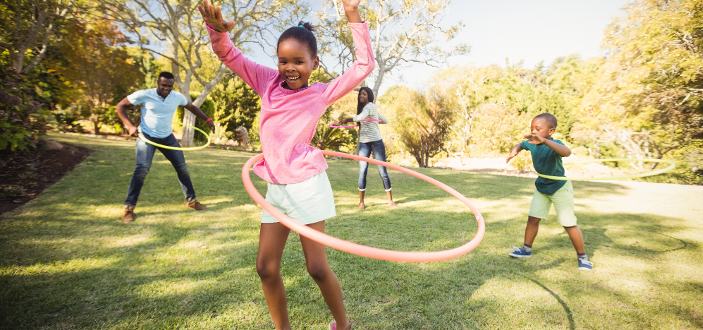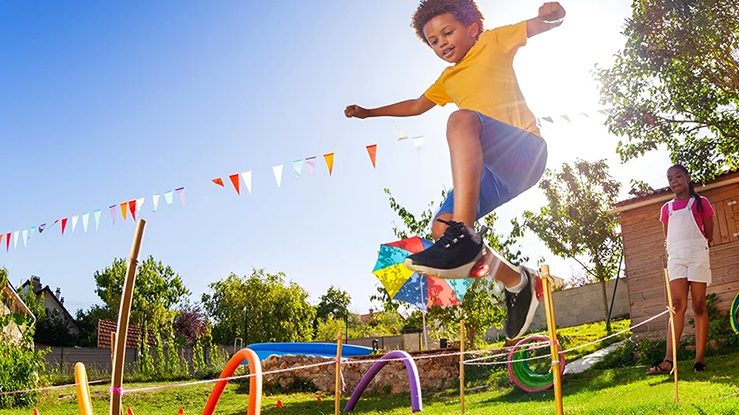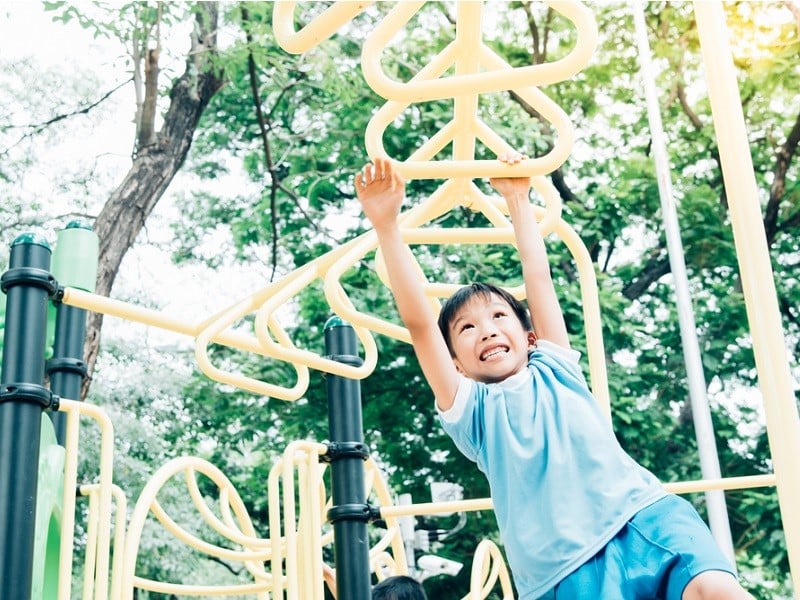Engaging in regular physical activity, including outdoor play, offers countless benefits of physical activity in children, supporting their physical, mental, and social development. Physical activity is essential for children’s growth, health, and overall well-being, impacting not only their physical health but also their mental and social skills. Through activities like outdoor play, children build lifelong habits that help them grow into healthy, active adults. Let’s explore the benefits of physical activity in children and how to encourage it at home, school, and in the community.
Physical Benefits of Physical Activity in Children:
Engaging in regular physical activity offers several physical health benefits for children, such as:
- Improved cardiovascular health – Exercise strengthens the heart, helping children stay active without fatigue.
- Stronger bones and muscles – Physical activities like running, jumping, and climbing enhance bone density and muscle growth.
- Better weight management – Physical activity can help children maintain a healthy weight and reduce the risk of obesity.
These physical benefits of physical activity in children lay the foundation for a healthier adult life.

Mental and Emotional Health Benefits of Physical Activity in Children:
Physical activity is equally important for mental health. Here’s how it benefits children emotionally and psychologically:
- Reduces anxiety and stress – Exercise releases endorphins, improving mood and reducing stress.
- Boosts self-esteem – Active children often have higher confidence and a positive body image.
- Improves focus and cognitive development – Exercise promotes concentration and enhances cognitive functions, making it easier for children to succeed academically.
These mental health benefits of physical activity support children’s emotional resilience and personal growth.
Social Benefits of Physical Activity for Children:
Participating in group activities and sports has positive effects on social skills and teamwork. The social benefits of physical activity in children include:
- Enhanced teamwork and communication skills – Group activities teach children to work together and solve problems collaboratively.
- Building friendships and social networks – Engaging with others in physical activities helps children form friendships and build a sense of belonging.
- Learning empathy and discipline – Sports and team play foster a sense of respect and empathy among peers.
These social interactions are invaluable for developing well-rounded individuals.

Benefits of Physical Activity in Schools:
Schools are a key environment for promoting physical activity. Here’s why physical activity in schools matters:
- Improved academic performance – Studies show that children who are active tend to perform better academically.
- Positive school atmosphere – Physical activity reduces behavioral issues, creating a more focused and positive learning environment.
- Increased energy and alertness – Regular exercise helps children stay energized and ready to learn throughout the day.
Schools can implement activities and breaks to ensure students experience these benefits of regular physical activity.
How to Promote Physical Activity in Schools and Communities:
Promoting exercise in schools and communities is vital for building a culture of health and wellness. Here are some effective ways to promote physical activity in the community:
- Community sports leagues – Local leagues provide structured activities and give children an opportunity to interact and stay active.
- School-based physical education – Schools can introduce varied sports, activities, and even phonics activities within games to support early literacy alongside physical development. This integrated approach keeps children engaged in both movement and learning.
- Outdoor community spaces – Parks and playgrounds encourage children to get outside, stay active, and explore.
How to promote physical activity in schools is equally essential. Schools can integrate daily exercise routines, sports days, and encourage students to participate in physical education classes.
Why Physical Activity Is Important for Child Development:
From a developmental perspective, physical activity is crucial for young children. Why is physical activity important for child development? Let’s explore:
- Developing motor skills – Physical activities build fine and gross motor skills, coordination, and balance.
- Building lifelong habits – Children who are active from a young age are more likely to continue healthy habits into adulthood.
- Supporting emotional regulation – Exercise can help children manage emotions and cope with challenges, promoting resilience.

Benefits of Physical Activity for Children’s Mental Health:
Benefits of physical activity for children’s mental health go beyond just reducing stress; they create a foundation for mental well-being. Here’s how:
- Decreased risk of depression – Exercise is a natural mood booster, lowering the risk of depression.
- Enhanced emotional expression – Physical activity allows children to express themselves and manage emotions healthily.
- Improved concentration and memory – Exercise promotes brain health, which improves focus and academic success.
Fostering mental health benefits of physical activity can help children feel more secure, happy, and confident.
10 Key Benefits of Physical Activity in Children:
To summarize, here are the 10 benefits of physical activity for children:
- Strengthens heart health and improves cardiovascular endurance.
- Supports healthy weight management and reduces obesity risk.
- Enhances bone density and muscle strength.
- Reduces anxiety and stress, supporting emotional health.
- Boosts self-confidence and encourages a positive body image.
- Improves focus, memory, and cognitive development.
- Teaches teamwork, cooperation, and social skills.
- Enhances academic performance and focus in school.
- Helps build lifelong healthy habits and personal resilience.
- Fosters a sense of community and social belonging.
Encouraging physical activity in your child’s life sets them up for success across physical, mental, and social domains.
Conclusion:
The benefits of physical activity in children span from fostering social benefits of physical activity, encouraging exercise helps children build critical skills that benefit them in school, at home, and within the community. From improved health benefits of physical activity to fostering social benefits of physical activity, encouraging exercise helps children build critical skills that benefit them in school, at home, and within the community.
Understanding the importance of physical activity in early childhood is essential, as it forms habits that can carry into adulthood, reducing health risks and promoting overall well-being. By emphasizing the benefits of physical activity in schools and community programs, we can help children develop healthy lifestyles that support their growth and learning. As parents, educators, and community members, we have the opportunity to support children in reaping the countless rewards of an active life.
FAQS:
How do you promote physical activity in early childhood?
To promote physical activity in early childhood, create a safe and engaging environment that encourages movement. Use age-appropriate games and outdoor play, incorporate short active breaks into daily routines, and model active behavior. Offering a variety of fun activities helps children discover the joy of staying active.
How can we encourage children to exercise?
Encourage children to exercise by making it enjoyable and accessible. Organize fun, interactive games, join them in physical activities, and praise their efforts. Creating a positive, supportive environment can help them associate exercise with fun and enjoyment.
What are three activities that promote children’s physical development?
- Running and jumping games – Improve cardiovascular fitness and coordination.
- Obstacle courses – Develops balance, strength, and problem-solving skills.
- Dancing – Boosts flexibility, rhythm, and muscle control.
How does play promote physical development in children?
Play promotes physical development by encouraging children to move, explore, and interact with their surroundings. Through activities like climbing, running, and balancing, children develop motor skills, strength, coordination, and confidence in their physical abilities.
What are the mental benefits of physical activity?
Physical activity reduces stress, boosts mood, and enhances focus by releasing endorphins. It also improves self-esteem and emotional resilience, supporting overall mental health and cognitive development in children.
External Resources:
Centers for Disease Control and Prevention (CDC) – Physical Activity Basics: A guide from the CDC on recommended physical activity levels for children and the benefits of staying active.
World Health Organization (WHO) – Physical Activity and Young People: WHO’s recommendations and insights into the physical and mental benefits of exercise for children and adolescents.
Mayo Clinic – Children and Exercise: Benefits and Guidelines: A comprehensive article from Mayo Clinic on the benefits of physical activity in children and tips for encouraging them to stay active.

Empowering parents to raise happy, confident kids. Get practical parenting tips and advice on our blog, Smart Parent Guides.
